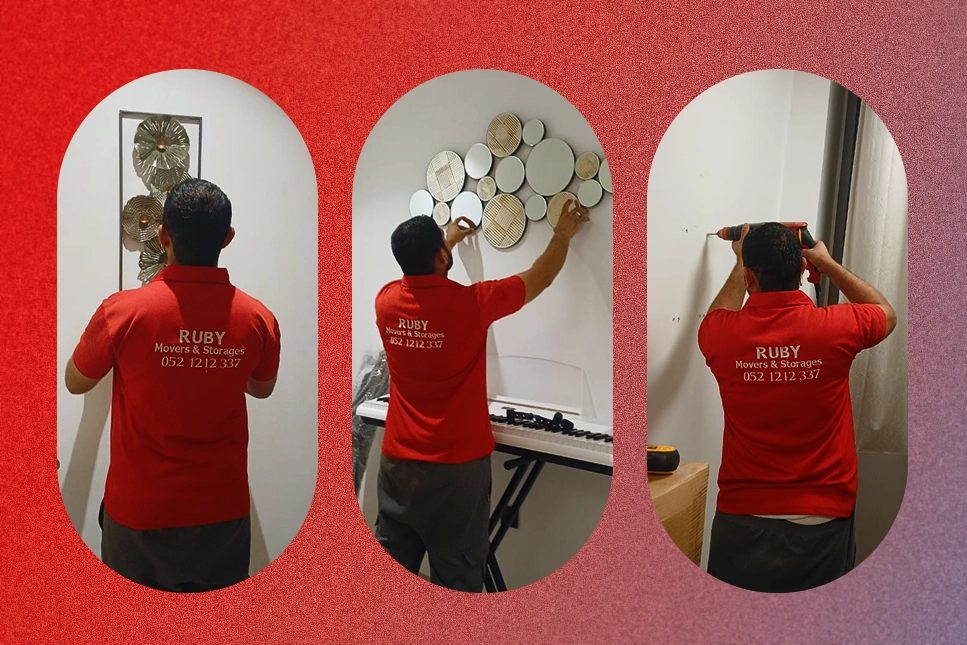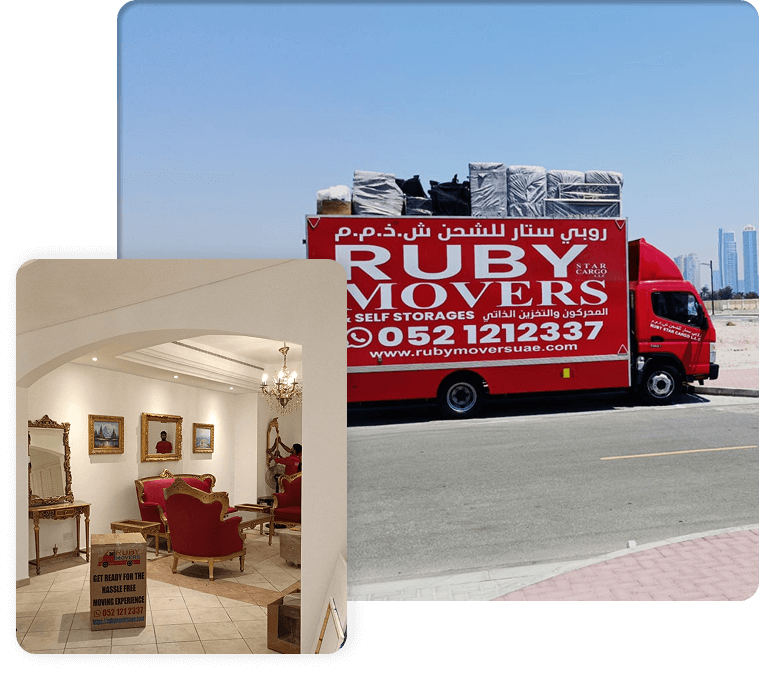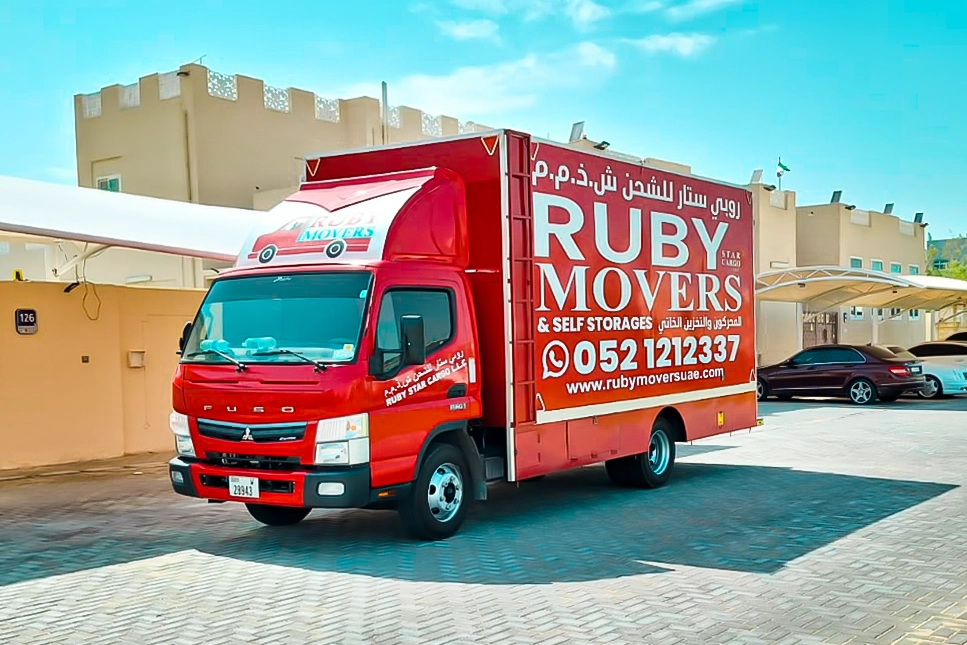Ras Al Khaimah is a challenge to relocate to, yet when making a long-distance journey, probably mainly between emirates, the problem of villas versus apartments becomes even more central. The by-words of movers in Ras Al Khaimah can also view this matter, where distance is a significant factor and villas will demand larger fleets, greater human resources, and even special rights, but apartments cannot be accommodated simply around elevators, car parks, and building regulations.
Here, this guide will provide a detailed analysis of villa vs apartment logistics in Ras Al Khaimah that is highly focused on the specifics of long-term relocation.

UAE Logistics Market: Why It Matters for Long Moves
Ras Al Khaimah is a unique location in the logistics industry in the UAE. As the farthest emirate to the north, Ras Al Khaimah (RAK) acts not only as a residence but also as a stepping-stone in business once a person decides to move an apartment or a villa on long journeys. Designed to be on road networks extending across multiple emirate states to the city of Dubai, Sharjah, and Abu Dhabi, these long-range transfers differ greatly in their reliance on either the Dubai, Sharjah, or Abu Dhabi intra-city road system.
1. Strategic Road Links: RAK has connections with Dubai on E311 (Sheikh Mohammed Bin Zayed Road) and E611 (Emirates Road), and also E11 (Sheikh Zayed Road) extends to Abu Dhabi. These highways are necessary routes to movers in Ras Al Khaimah, yet they are associated with a toll fee, gasoline expenses, and penalties associated with traveling. A one-way movement of a single relocation truck through several Salik toll stations may increase the toll costs by AED 24-36.
2. Distance Amplifies Villa vs Apartment Differences: Distance between Ras al-Khaimah and Dubai is 112 kilometers (69 miles), typically requiring 1.5 to 2 hours of travel, while the distance between Ras Al Khaimah and Abu Dhabi is approximately 250 km and can stretch up to 3 hours. Movers in Ras Al Khaimah note that these longer routes magnify villa relocation costs more than apartment costs because villas usually need multiple trucks, more crew-hours, and heavier loads. Apartments, while smaller, are affected by time-bound access restrictions at destinations, adding logistical pressure on movers.
3. Logistics Growth & Demand: The UAE freight and logistics market itself is valued at USD 21.63 billion in 2025 and expected to grow to USD 30.19 billion by 2030, reflecting increased demand for long-route relocation services. Ras Al Khaimah contributes to this demand through its residential communities, where relocation often involves inter-emirate long hauls rather than local short moves.
Why it matters: Movers in Ras Al Khaimah cannot price or plan relocations without accounting for geography, fuel, tolls, and distance-related risks. For clients, this means villa and apartment logistics are not only about property size but also about the realities of long-route infrastructure across the UAE.
The Real Price of Moving in Ras Al Khaimah: Villas vs Apartments on Long Routes
When families in Ras Al Khaimah plan a relocation, cost is often the deciding factor. However, the final bill rarely reflects just the base quote. Movers in Ras Al Khaimah emphasize that the property type, villa or apartment, determines not only the size of the load but also the accumulation of hidden charges that increase with distance.
Hidden Costs That Add Up on Long Routes
1. Permits and Approvals: Heavy trucks moving villa loads across the Emirates often need special permits costing between AED 500 and AED 1,500, depending on vehicle size and route. Apartments usually avoid these unless oversized furniture requires special handling.
2. Toll Gates (Salik Fees): Each Salik gate adds AED 4. A RAK to Dubai villa move with two trucks passing through 3–4 gates could add AED 24–32 per truck, doubling the total cost compared to an apartment that needs just one truck.
3. Fuel Surcharges: For long routes, movers in Ras Al Khaimah add 10–20% fuel surcharges. Villas, with heavier loads and multiple trips, consume far more diesel than compact apartment moves.
Cost-Per-Kilometer Estimates
Breaking costs into per-kilometer rates provides a clearer picture:
| Route | Apartment Move | Villa Move | Notes |
|---|---|---|---|
| RAK → Dubai (120 km) | ~AED 10–15/km (Total AED 1,200–1,800) | ~AED 20–30/km (Total AED 4,000–6,000) | Villas often require 2 trucks. |
| RAK → Sharjah (90 km) | ~AED 9–14/km (Total AED 900–1,300) | ~AED 18–28/km (Total AED 3,200–5,000) | Villa crews = 6–8 movers. |
| RAK → Abu Dhabi (250 km) | ~AED 12–16/km (Total AED 3,000–4,000) | ~AED 22–35/km (Total AED 6,000–9,000) | Fuel surcharges apply heavily. |
Why Villas Cost More per Kilometer
- Multiple Vehicles: Villas frequently require two or more 3–5 ton trucks, doubling toll and fuel costs.
- Permit Multipliers: Heavy-load permits of AED 500–1,500 per truck weigh more heavily on villa budgets.
- Crew Overstretch: Each additional 100 km adds 1–2 extra crew-hours, multiplying total labor costs faster for villas than for apartments.
A villa relocation from Ras Al Khaimah to Abu Dhabi can cost twice or even three times as much as an apartment move on the same corridor.

Measuring Time Efficiency: How Villa and Apartment Relocations in Ras Al Khaimah Diverge on Long Routes
In Ras Al Khaimah, the clock is as important as the cost when comparing villa and apartment moves. While both property types use the same highways (E311, E611, and E11), the way time accumulates differs sharply once movers account for packing density, crew coordination, and checkpoint delays. Movers in Ras Al Khaimah note that long routes make these differences more visible than short intra-city shifts.
Villa Relocations: Why Hours Multiply
- Villas typically hold more inventory than apartments, and every additional piece of bulky furniture adds minutes during both loading and unloading.
- The average villa move from Ras Al Khaimah to Dubai spans 10–14 hours, almost double the apartment timeline.
- Outdoor fixtures, like pergolas, garden sets, and gym equipment, extend the schedule by 1–2 hours on their own.
Apartment Relocations: Faster, But Not Always Smooth
- Apartment moves average 6–8 hours on the RAK–Dubai route, but high-rise restrictions can cancel out speed advantages.
- Elevators booked in two-hour slots create bottlenecks; if missed, movers wait until the next window, adding 30–60 minutes.
- Parking zones in dense urban centers like Dubai Marina or Downtown Dubai also extend unloading times by up to 45 minutes.
Seasonal and Traffic Variables
- Peak summer traffic on UAE highways can extend long-route travel by 20–30 minutes, particularly near Sharjah bottlenecks.
- Long weekends increase road volume, pushing villa moves dangerously close to 15–16 hours. Apartments typically finish earlier, but may still stretch beyond the planned window if building access is restricted.
Human Resources Behind the Move: Villa vs Apartment Crew Demands in Ras Al Khaimah
Every successful long-route relocation in Ras Al Khaimah depends on manpower. While trucks and packing materials are visible costs, the crew structure is what actually drives the operation’s efficiency and final bill. Movers in Ras Al Khaimah highlight that villas and apartments require very different workforce arrangements.
Apartment Relocations: Small Teams, Streamlined Roles
- A standard 1–3 bedroom apartment move typically involves 3–5 movers and one truck.
- Crew focus is on efficient packing, navigating stairwells, and elevator coordination, since vertical movement is the main challenge in high-rise buildings.
- Labor time usually stays between 18–40 crew-hours in total, depending on distance and loading restrictions.

Villa Relocations: Larger Teams, Specialized Tasks
- A 3–5 bedroom villa often needs 6–10 movers and at least two trucks, particularly for long-route relocations.
- Villas require specialized roles, such as furniture disassembly experts, outdoor equipment handlers, and drivers trained for heavy-load transport.
- Crew-hour totals can reach 60–120 hours on long routes, which directly inflates costs.
Wage Impact on Long-Route Logistics
- Movers in Ras Al Khaimah generally charge AED 80–150 per hour per mover.
- The labor cost gap widens quickly:
Apartment (RAK–Dubai): ~AED 1,500–2,500 in labor.
Villa (RAK–Dubai): ~AED 4,800–9,000 in labor.
- This difference explains why villa relocations cost 2–3× more than apartments, even on the same long route.
Why Crew Requirements Differ
- Villas: Heavy furniture, multiple floors, and outdoor assets demand more hands.
- Apartments: Labor intensity shifts toward waiting time (elevator slots, security checks) rather than disassembly or carrying oversized items.
Key Insight: Labor is the hidden multiplier in villa relocations. For every additional 100 km on a long route, the crew requirement compounds faster for villas than for apartments, making human resources the decisive cost factor in Ras Al Khaimah’s moving logistics.
Why Insurance Defines the Safety of Long-Route Moves in Ras Al Khaimah
Imagine a family shifting from a villa in Al Hamra Village to a new property in Abu Dhabi. The trucks carry chandeliers, gym machines, and antique wooden sets across 250 kilometers of busy highways. Now imagine another family moving from a 2-bedroom apartment in RAK City to Dubai Marina with only compact furniture and boxes. The difference in risk exposure is clear, and insurance is what bridges that gap.
- Villa relocations carry more minor damage incidents than apartment moves, mostly because of load size and handling frequency.
- Movers in Ras Al Khaimah often recommend that villa owners opt for policies of AED 50,000–100,000. On the other hand, apartment movers usually stay within AED 10,000–20,000 coverage brackets.
The bottom line: Insurance is not some check box functionality, but rather a coverage that is determined by the item being covered. Value and complexity in the case of the villas demand their increased coverage, but in the case of the apartments, coverage is limited, but is equally essential. The result of not being a part of this process can make a long route out of Ras Al Khaimah an economic disadvantage.
Storage-in-Transit: The Overlooked Factor in Ras Al Khaimah Long-Route Moves
One of the little spoken barriers of moving out of Ras Al Khaimah to the other emirates is what happens when your new suburban house fails to be completed in time. The delayed keys, handover delays, and overlays between the tenancy dates are some of the frequent conditions that movers have to deal with in Ras Al Khaimah. In these conditions, storage-in-transit (SIT) adopts the risk reduction plan that contributes to preserving the belongings during the intermediate stage before arrival at the destination.
- When it comes to SIT services, villas make up the majority of cases. The sheer volume of furniture and outdoor items makes it impractical for movers to manage long-distance truck transfers alone. That’s why storage facilities play a central role, starting at around AED 2,000 per month, offering both room for belongings and security assurances.
- Rather, apartments use SIT less frequently, but in some instances, situations occur where the overlaps in the tenancies require short-term storage that is normally between AED 500 and AED 1,200 each month.
Key Insight: Moving long distances around Ras Al Khaimah isn’t just about loading a truck. You also need to think carefully about storage. Villas can be tricky, with handover delays slowing things down, while smaller deliveries are best kept in the budget apartment storage for a short time. If you plan storage in advance, you’ll save money and make the whole move less of a hassle.

Time as a Cost Driver in Ras Al Khaimah Long-Route Moves
Moving costs across the UAE depend on several factors, with time being just as critical as distance or fleet size. Villa relocations, movers in Ras Al Khaimah explain, demand far more hours than apartment shifts. Over longer routes, this time gap directly results in a rise in overall expenses. Labor is billed hourly, so every extra minute on-site or on the road increases the total invoice.
Comparing the Timelines: Apartment vs Villa
| Process | Apartment (3 BR) | Villa (3 BR) |
|---|---|---|
| Packing & Loading | 2–3 hrs | 4–6 hrs |
| Travel (RAK → Dubai/Abu Dhabi) | 2–4 hrs | 2–4 hrs |
| Secondary Transfer / Access | 0–0.5 hr | 1–2 hrs |
| Unloading & Setup | 1–2 hrs | 2–3 hrs |
| Total Time | 5–9 hrs | 9–15 hrs |
- Apartments benefit from smaller loads and fewer handling stages, averaging 5–9 hours for a full relocation.
- Villas typically require 9–15 hours, with extra time consumed by bulky furniture disassembly, outdoor equipment, and multi-truck coordination.
Why Time Multiplies for Villas
- More crew on-site: A villa team often doubles the size of an apartment crew. Even small delays compound across multiple movers.
- Secondary transfers: Villas sometimes involve narrow streets or gated communities, forcing movers to stage items through smaller vehicles. This adds 1–2 hours to long-route relocations.
- Setup at destination: Garden sets, pergolas, and large appliances take longer to reassemble compared to compact apartment furniture.
Economic Impact of Delays
With crew members in the UAE charging AED 80–150 per hour, an additional 4–6 hours for villas can inflate the bill by AED 2,000–5,000 compared to apartments. Movers in Ras Al Khaimah confirm that villa relocations on long routes take 1.7×–2× the time, making time the invisible cost driver that clients often underestimate.
Key Insight: Time is not neutral in long-route logistics. For apartments, efficient elevator use and compact packing keep relocations contained. For villas, time expands with scale and complexity, and on long routes, this difference becomes the biggest cost multiplier.
Best Practices for Smooth Long-Route Moves
Whether villa or apartment, planning reduces stress and cost. Movers in Ras Al Khaimah recommend:
For Villas
- Create a detailed inventory list with dimensions.
- Split fragile vs bulky loads across vehicles.
- Insure goods for AED 50,000 or more.
For Apartments
- Pre-book elevators weeks in advance.
- Confirm parking permits for truck access.
- Move off-peak hours to bypass traffic delays.

Expert Insights: Tech & Efficiency Gains
Technology is transforming how movers in Ras Al Khaimah manage villa and apartment relocations.
- Route optimization software reduced delivery costs and fleet size.
- The UAE green logistics market generated a revenue of USD 18,892.9 million in 2024 and is expected to reach USD 28,067.6 million by 2030.
- IoT sensors and GPS trackers help movers protect luxury villa furniture and manage inventory in real-time.
Conclusion: Choosing the Right Path for Long-Route Relocations in Ras Al Khaimah
Long-route relocations in Ras Al Khaimah highlight the sharp contrasts between villa and apartment moves. Villas demand more trucks, larger crews, extended hours, and higher insurance, making them almost 2–3× costlier and slower than apartment moves on the same routes. Apartments, while smaller and cheaper to move, face unique urban challenges such as elevator restrictions, limited parking, and strict building permits.
Movers in Ras Al Khaimah stress that long-route logistics are not just about distancethey are about how property type interacts with time, cost, manpower, and risk. With the right planning, both villa and apartment relocations can be executed smoothly, even across Ras Al Khaimah’s longest routes.
FAQs
Why are villa relocations in Ras Al Khaimah more expensive than apartment relocations?
Villas require multiple trucks, larger moving crews, and more time for packing, loading, and assembly. Insurance and permits also add costs, making villa relocations 2–3× more expensive than apartments on long routes.
How long does it take to move from Ras Al Khaimah to Dubai or Abu Dhabi?
On average, apartment moves take 6–9 hours for RAK–Dubai, while villas take 10–15 hours. For RAK–Abu Dhabi, timelines extend up to 14–18 hours, depending on property size and road conditions.
Do movers in Ras Al Khaimah charge per kilometer or a flat rate?
Most movers use hybrid pricing: base rates plus per-kilometer charges. Apartments average AED 10–15/km, while villas cost AED 20–30/km due to multiple trucks and heavier loads.
Are special permits required for villa relocations across the Emirates?
Yes. Villa relocations often require heavy-load permits costing AED 500–1,500 per truck, especially for long routes. Apartments usually avoid these unless oversized furniture is involved.
How do tolls affect relocation costs?
Every Salik toll gate charges AED 4. An apartment move may add AED 16–24 total, while villas with two trucks can face AED 32–48 or more in tolls.
What insurance coverage do movers recommend in Ras Al Khaimah?
Movers suggest AED 50,000–100,000 insurance for villas due to high-value furniture, and AED 10,000–20,000 for apartments. Long routes increase risk exposure, making coverage essential.
Do apartment moves face unique challenges compared to villas?
Yes. Apartments face elevator slot restrictions, parking access issues, and building permit requirements, which can delay long-route relocations even if the load is smaller.
What role does manpower play in long-route moves?
Apartments use 3–5 movers and one truck, while villas need 6–10 movers and multiple trucks. Labor is billed at AED 80–150/hour, making villas significantly more expensive in terms of crew-hours.
Do movers in Ras Al Khaimah offer storage-in-transit (SIT)?
Yes. Villas frequently require SIT due to delayed handovers, costing AED 2,000+ monthly. Apartments use SIT less often, but it’s available for AED 500–1,200/month when tenancy overlaps occur.





